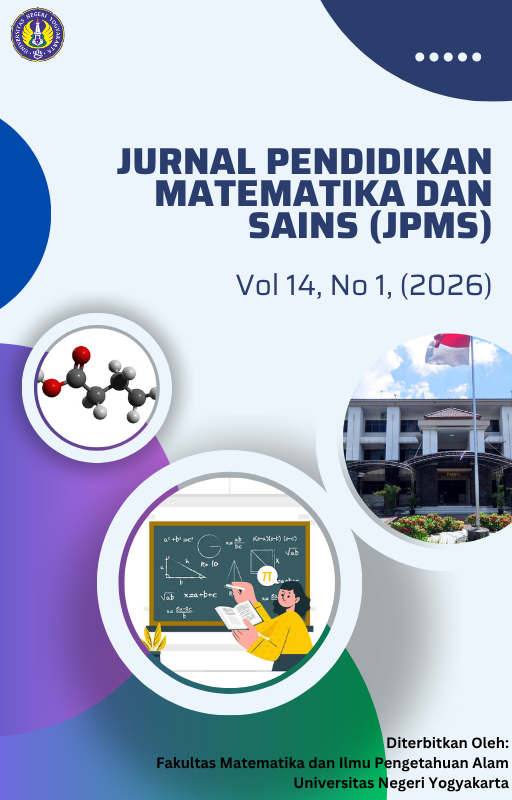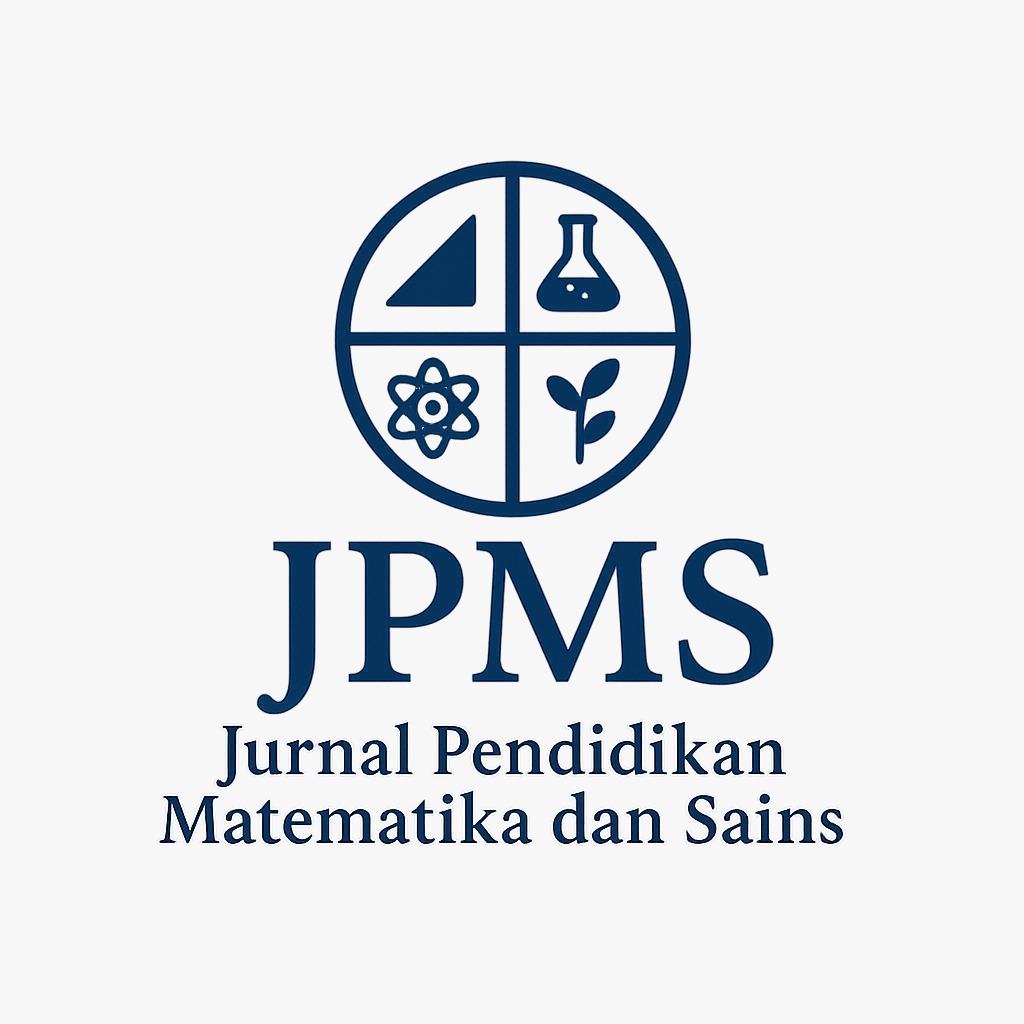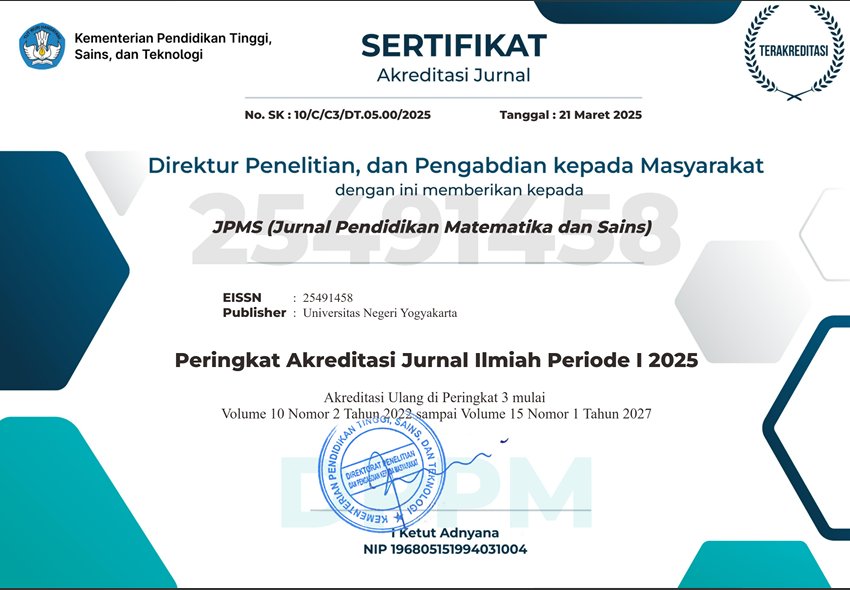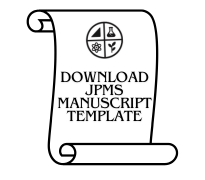Analysis of The Thermodynamics Problem-solving Process Based on Polya’s Stages in High School Students
DOI:
https://doi.org/10.21831/jpms.v14i1.90339Keywords:
Polya, Problem-solving skills, ThermodynamicsAbstract
This research was motivated by the importance of problem-solving skills as part of the higher-order thinking skills required in physics learning, especially in complex and abstract thermodynamics materials. The complexity of materials, including internal energy, ideal gases, and the laws of thermodynamics, often caused difficulties for students in understanding and solving problems. This study aimed to analyze students’ problem-solving skills in thermodynamics based on Polya’s problem-solving stages. The research employed a survey method involving 36 students who completed a problem-solving test covering topics of internal energy, ideal gas, and the laws of thermodynamics. The overall problem-solving score was 53,59%, categorized as low. The highest achievement was in understanding the problem (64,8%, moderate), followed by devising a plan (54,01%, low), carrying out the plan (46,60%, low), and looking back (45,37%, low). These results indicated that students experienced difficulties in selecting appropriate concepts, applying relevant formulas, and evaluating solutions systematically. The findings suggested that students’ problem-solving skills in thermodynamics remained weak and required more effective instructional approaches. This study contributed to the achievement of Sustainable Development Goal 4 (Quality Education) by highlighting the need to enhance problem-solving skills to improve the quality of physics education.
References
Akbar, P., Hamid, A., Bernard, M., & Sugandi, A. I. (2017). Analisis kemampuan pemecahan masalah dan disposisi matematik siswa kelas XI SMA Putra Juang dalam materi peluang. Jurnal Cendekia: Jurnal Pendidikan Matematika, 2(1), 144–153. https://doi.org/10.31004/cendekia.v2i1.62
Amanda, N., Nusantara, T., Studi, P., Matematika, P., Matematika, F., & Alam, P. (2020). Analisis berpikir kritis siswa terhadap pemecahan masalah matematika di MTs Surya Buana Malang. Jurnal Pendidikan Matematika dan Sains, 8(2), 89–92. https://doi.org/10.21831/jpms.v8i2.19660
Anwar, S., & Amin, S. M. (2013). Penggunaan langkah pemecahan masalah Polya dalam menyelesaikan soal cerita pada materi perbandingan di kelas VI MI Al-Ibrohimy Galis Bangkalan. Jurnal Pendidikan Matematika e-Pensa, 01(01), 1–6. https://doi.org/10.26740/mathedunesa.v2n3.p%25p
Chinofunga, M. D., Chigeza, P., & Taylor, S. (2025). How can procedural flowcharts support the development of mathematics problem-solving skills? Mathematics Education Research Journal, 37, 85–123. https://doi.org/10.1007/s13394-024-00483-3
Christensen, W. M., Meltzer, D. E., & Ogilvie, C. A. (2009). Student ideas regarding entropy and the second law of thermodynamics in an introductory physics course. American Journal of Physics, 77(10), 907–917. https://doi.org/10.1119/1.3167357
Darmawan, A., Asa, B. N., Kurniawan, F., Nukhba, R., Albab, U., & Parno, P. (2020). Pengembangan instrumen tes pemecahan masalah bagi mahasiswa jurusan fisika pada materi dinamika partikel. Jurnal Pendidikan Fisika dan Keilmuan (JPFK), 6(1), 55–64. https://doi.org/10.25273/jpfk.v6i1.5579
Docktor, J. L., Strand, N. E., Mestre, J. P., & Ross, B. H. (2015). Conceptual problem solving in high school physics. Physical Review Special Topics - Physics Education Research, 11(2), 1–13. https://doi.org/10.1103/PhysRevSTPER.11.020106
Dumila, S. M., Nurhayati, N., & Mariyam, M. (2023). Pengaruh model pembelajaran problem posing terhadap kemampuan pemecahan masalah matematis siswa pada materi linier satu variabel kelas VII SMP. Jurnal Pendidikan Matematika dan Sains, 11(2), 67–76. https://doi.org/10.21831/jpms.v11i2.51504
Effendi, L. A. (2012). Pembelajaran matematika dengan metode penemuan terbimbing untuk meningkatkan kemampuan representasi dan pemecahan masalah matematis siswa SMP. Jurnal Penelitian Pendidikan, 13(2), 1–10.
Farahhadi, S. D., & Wardono. (2019). Representasi matematis dalam pemecahan masalah. RPRISMA, Prosiding Seminar Nasional Matematika, 606–610. https://journal.unnes.ac.id/sju/index.php/prisma/
Fatmawati, H., Mardiyana, & Triyanto. (2014). Analisis berpikir kritis siswa dalam pemecahan masalah matematika berdasarkan Polya pada pokok bahasan persamaan kuadrat. Jurnal Pembelajaran Matematika, 2(9), 899–910. http://jurnal.fkip.uns.ac.id
Gok, T. (2014). Students’ achievement, skill and confidence in using stepwise problem-solving strategies. Eurasia Journal of Mathematics, Science and Technology Education, 10(6), 617–624. https://doi.org/10.12973/eurasia.2014.1223a
Hadi, S., & Radiyatul, R. (2014). Metode pemecahan masalah menurut Polya untuk mengembangkan kemampuan siswa dalam pemecahan masalah matematis di sekolah menengah pertama. EDU-MAT: Jurnal Pendidikan Matematika, 2(1), 53–61. https://doi.org/10.20527/edumat.v2i1.603
Hana, A. Y., Sa’diyah, H., Nahar, Z. K., & Fakhriyana, D. (2024). Pendidikan Berkualitas untuk mewujudkan sustainable development goals (SDGs) melalui pembelajaran matematika: Systematic literature review. Arithmetic: Academic Journal of Math, 06(01), 79–100. https://doi.org/10.29240/ja.v6i1.9118
Hijriani, & Hatibe, A. (2021). Analisis kesulitan belajar dalam memecahkan masalah fisika pada materi hukum Newton tentang gerak. JPFT: Jurnal Pendidikan Fisika Tadulako Online, 9(1), 45–49. https://doi.org/10.22487/jpft.v9i1.788
Ilma, K. N., Maulidah, R., & Susanti, E. (2024). The effect of the process-oriented guided inquiry learning model on students’ problem-solving skills in the first law of thermodynamics. Jurnal Penelitian Pendidikan IPA, 10(11), 8686–8692. https://doi.org/10.29303/jppipa.v10i11.4819
La’ia, H. T., & Harefa, D. (2021). Hubungan kemampuan pemecahan masalah matematis dengan kemampuan komunikasi matematik siswa. Aksara: Jurnal Ilmu Pendidikan Nonformal, 7(2), 463–474. https://doi.org/10.37905/aksara.7.2.463-474.2021
Lubis, A. P., & Maysarah, S. (2025). Pengaruh model pembelajaran kooperatif tipe think pair share terhadap kemampuan komunikasi dan pemecahan masalah matematis. Jurnal Pendidikan Matematika dan Sains, 13, 92–101. https://doi.org/10.21831/jpms.v13iSpecial_issue.88788
Malik, A., Nuraeni, Y., Samsudin, A., & Sutarno, S. (2019). Creative thinking skills of students on harmonic vibration using model student facilitator and explaining (SFAE). Jurnal Ilmiah Pendidikan Fisika Al-Biruni, 8(1), 77–88. https://doi.org/10.24042/jipfalbiruni.v8i1.3056
Mason, A., & Singh, C. (2016). Using categorization of problems as an instructional tool to help introductory students learn physics. Physics Education, 51(2), 1–5. https://doi.org/10.1088/0031-9120/51/2/025009
Muyambo-Goto, O., Naidoo, D., & Kennedy, K. J. (2023). Students’ conceptions of 21st century education in Zimbabwe. Interchange, 54(1), 49–80. https://doi.org/10.1007/s10780-022-09483-3
Napis. (2018). Analysis of physics problem solving in the perspective of self efficacy and adversity quotient. Formatif: Jurnal Ilmiah Pendidikan MIPA, 8(1), 31–42. https://doi.org/10.30998/formatif.v8i1.2298
Nayazik, A. (2017). Pembentukan keterampilan pemecahan masalah melalui model IDEAL problem solving dengan teori pemrosesan informasi. Kreano, Jurnal Matematika Kreatif-Inovatif, 8(2), 182–190. https://doi.org/10.15294/kreano.v8i2.7163
Nurkaeti, N. (2018). Polya’s strategy: An analysis of mathematical problem solving difficulty in 5th grade elementary school. EduHumaniora: Jurnal Pendidikan Dasar Kampus Cibiru, 10(2), 140–147. https://doi.org/10.17509/eh.v10i2.10868
Okafor, T. U. (2019). Effect of Polya’s problem solving technique on the academic achievement of senior student in physics. European J of Physics Education, 10(1), 1309–7202. https://doi.org/10.20308/EJPE.V10I1.233
Olaniyan, A. O., & Govender, N. (2018). Effectiveness of Polya problem-solving and target-task collaborative learning approaches in electricity among high school physics students. Journal of Baltic Science Education, 17(5), 765–777. https://doi.org/10.33225/jbse/18.17.765
Pasigon, C. P. (2022). Attributes of students towards problem solving in physics: a step towards students’ capacity building. Journal of Positive School Psychology, 6(10), 531–544. https://journalppw.com/index.php/jpsp/article/view/13138%0A
Polya, G. (1973). How to solve it. Princeton University Press.
Rahman, M. M. (2019). 21st century skill “problem solving”: defining the concept. Asian Journal of Interdisciplinary Research, 2(1), 71–81. https://doi.org/10.34256/ajir1917
Septriansyah, A., Imamuddin, M., Apriyanti, D., & Pelitawaty, M. D. (2022). Students’ mathematical problem solving skills in solving HOTS problems. Edumatika: Jurnal Riset Pendidikan Matematika, 5(2), 134–143. https://doi.org/10.32939/ejrpm.v5i2.1604
Setianingrum, L., Parno, & Sutopo. (2016). Analisis kemampuan pemecahan masalah fisika siswa SMK. Seminar Nasional Jurusan Fisika FPMIPA UM, 5–10.
Simatupang, R., Napitupulu, E., & Asmin. (2020). Analisis kemampuan pemecahan masalah matematis dan self-efficacy siswa pada pembelajaran problem based learning. Paradikma: Jurnal Pendidikan Matematika, 13(1), 29–39. https://doi.org/10.24114/paradikma.v13i1.22944
Singh, C., & Marshman, E. (2015). Review of student difficulties in upper-level quantum mechanics. Physics Education Research, 11(2), 1–24. https://doi.org/10.1103/PhysRevSTPER.11.020117
Siringoringo, E., Yaumi, M. R., Santhalia, P. W., & Kusairi, S. (2018). Kemampuan pemecahan masalah siswa kelas XI SMA pada materi suhu dan kalor. Jurnal Pendidikan Matematika dan Sains, 6(2), 114–122.
Sweller, J. (1994). Cognitive load theory, learning difficulty, and instructional design. learning and instruction, 4(4), 295–312. https://doi.org/10.1016/0959-4752(94)90003-5
Tawfik, A. A., Graesser, A., Gatewood, J., & Gishbaugher, J. (2020). Role of questions in inquiry-based instruction: Towards a design taxonomy for question-asking and implications for design. Educational Technology Research and Development, 68, 653–678. https://doi.org/10.1007/s11423-020-09738-9
Ulya, H. (2016). Profil kemampuan pemecahan masalah pada siswa bermotivasi belajar tinggi berdasarkan IDEAL problem solving. Jurnal Konseling GUSJIGANG, 2(1), 90–96.
Wantrilita, A., & Rohaeti, E. (2025). The effect of PBL-STEM on improving problem problem-solving ability and self-efficacy of vocational high school students. Jurnal Pendidikan Matematika dan Sains, 13, 226–236. https://doi.org/10.21831/jpms.v13iSpecial_issue.89341
Widodo, S., & Kartikasari. (2017). Pembelajaran pemecahan masalah matematis siswa sekolah dasar dengan model creative problem solving (CPS). Jurnal PRISMA Universitas Suryakencana, 6(1), 57–65. https://doi.org/10.35194/jp.v6i1.28
Yayuk, E., & Husamah, H. (2020). The difficulties of prospective elementary school teachers in item problem solving for mathematics: Polya’s steps. Journal for the Education of Gifted Young Scientists, 8(1), 361–378. https://doi.org/10.17478/jegys.665833
Yuhani, A., Zanthy, L. S., & Hendriana, H. (2018). Pengaruh pembelajaran berbasis masalah terhadap kemampuan pemecahan masalah matematis siswa SMP. JPMI (Jurnal Pembelajaran Matematika Inovatif), 1(3), 445–452. https://doi.org/10.22460/jpmi.v1i3.p445-452
Yusra, R. A., Kusumah, F. H., & Suryadi, A. (2025). Pengaruh PjBL-STEM terhadap peningkatan keterampilan berpikir kritis pada materi energi terbarukan dalam mendukung pendidikan yang berkualitas. Jurnal Pendidikan Matematika dan Sains, 13, 26–37. https://doi.org/https://doi.org/10.21831/jpms.v13iSpecial_issue.86537
Downloads
Published
How to Cite
Issue
Section
Citation Check
License

This work is licensed under a Creative Commons Attribution-ShareAlike 4.0 International License.
Jurnal Pendidikan Matematika dan Sains allows readers to read, download, copy, distribute, print, search, or link to its articles' full texts and allows readers to use them for any other lawful purpose. The journal allows the author(s) to hold the copyright without restrictions. Finally, the journal allows the author(s) to retain publishing rights without restrictions
- Authors are allowed to archive their submitted article in an open access repository
- Authors are allowed to archive the final published article in an open access repository with an acknowledgment of its initial publication in this journal

This work is licensed under a Creative Commons Attribution-ShareAlike 4.0 Generic License.





